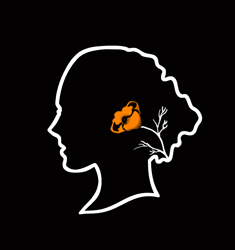“A great day of fishing is flat water, warm sun, and lots of seafood.”
Stephanie Mutz, Sea Urchin and Whelk Diver
President of Commercial Fishermen of Santa Barbara
Stephanie Mutz, oil on linen, 24x36
Stephanie Mutz appears to be a quintessential California girl. Raised in the surfing culture of Newport Beach, her dad was a key influence in her love of the ocean. “I grew up surfing, waterskiing on the ocean, and free-diving for dinner. We’d catch lobster, crab, and scallops. We just took what we needed – I still practice that.”
Stephanie is a businesswoman and commercial fisherman; as a woman she is an anomaly among her “salty dog” colleagues. “As a fisherman I’m very lucky – I’ve gotten the opportunity to learn from a lot of fishermen in the community. I think a lot of people appreciate my political efforts. I’m grateful for being part of this community.” Stephanie has earned respect through her advocacy for commercial fisherman and for their sustainability efforts.
“Fishermen want certain regulations – the seafood in our own backyard is the most responsibly caught in the world. I give a lot of accolades to the fishermen in our community.”
Stephanie first came to Santa Barbara twenty years ago to study marine biology at UCSB. “I was given good opportunities.” As part of her studies she lived in Tahiti for a couple of years, “I got paid to count fish – damsel fish, different species. After I came back to Santa Barbara I got a good job counting fish and invertebrates from Oregon to Mexico, mostly on the Channel Islands.” She was involved in collecting data for long-term ecological surveys. “When you start knowing why things happen, what they’re called, it’s more interesting. I’m still learning.”
After completing her undergraduate degree she went to Australia to work with tropical ecologist Howard Choat at James Cook University. Her research subject was the Acanthurids, which include the tropical surgeonfish. She studied otoliths (fish earbones) to look at age-size frequencies. “The otolith has rings that you can count, like tree-rings.”
“I went to grad school so that I could teach at a college.” Her return to California coincided with the recession, a time when college classes were being cut. “I got a job as a deck-hand and got into the politics of fishing. My interest was in fisheries. I went to a lot of meetings – one day in fins and the next in heels. Fishing, meetings, education, outreach – I saw a future in fishing. I focused on developing a business.”
“Fishermen are an important part of our community because we provide a healthy protein source. Done properly, it’s extremely sustainable. We can only take enough for the species to reproduce – we’re learning the thresholds to limit our take. That can be difficult if the price isn’t adjusted as well. I need to take into account how much it costs to go fishing and set aside [funds] for boat repairs and bad weather.”
As president of Commercial Fishermen of Santa Barbara, she is a respected advocate for her community and for sustainable practices. She also remains actively involved in education and outreach, and teaches part-time in the Ventura Community Colleges.
When asked what she’d like to see in the future of fishing, Stephanie has some clear ideas. “I’d like to see a fishing heritage – a local wild source, an industry that fishes responsibly. I’d like to see consumers educated about where their seafood comes from. Seafood is confusing – it could be less confusing if it passes through fewer hands. For the next generation of fishermen, I hope for plenty of seafood. With good management there’s a future in this business.”
“I fish up north to Point Conception, to Santa Cruz Island and Santa Rosa. It’s a dangerous job. If you lose a colleague – that’s the worst. You can have broken boats, bad weather. [You can] get skunked – the fish aren’t there. It’s not a certainty. My life is the same as fishermen a hundred years ago. I appreciate the freedom, I’m the boss. Every day is different.” Stephanie fishes alone in the Santa Barbara Channel, from her 20 foot panga. She collects each whelk individually, sometimes diving 40 feet.
“I go to my secret spot, I have a bag, a rake, and a measuring gauge. I open a few [urchins] to see if the quality is good – I fill the bag. I sell to restaurants, sometimes to a processor.” To savor the best uni, it must be absolutely fresh. “Alum is used as a preservative for uni – it changes the taste.” Urchin fresh from the sea is a salty and sweet delicacy.
“We have a Community Supported Fishery, which I co-founded. Our customers sign-up for 12- weeks of fresh local seafood. They know where it was caught and who caught it. Along with the catch we include management policy information and recipes.”
Another local resource is the Saturday fish market at the Santa Barbara harbor. Stephanie suggests, “Talk to your local fishermen, find out where your seafood comes from.” You may even meet Stephanie there.
For more about Stephanie and Community Supported Fishery (CSF) sustainable seafood, see these websites: www.seastephaniefish.com and www.communityseafood.com.
By Katherine Bradford


